Fuente Dé: Contador's Revolution
How an innocuous transition stage produced historic drama and defined the Spaniard's career and identity
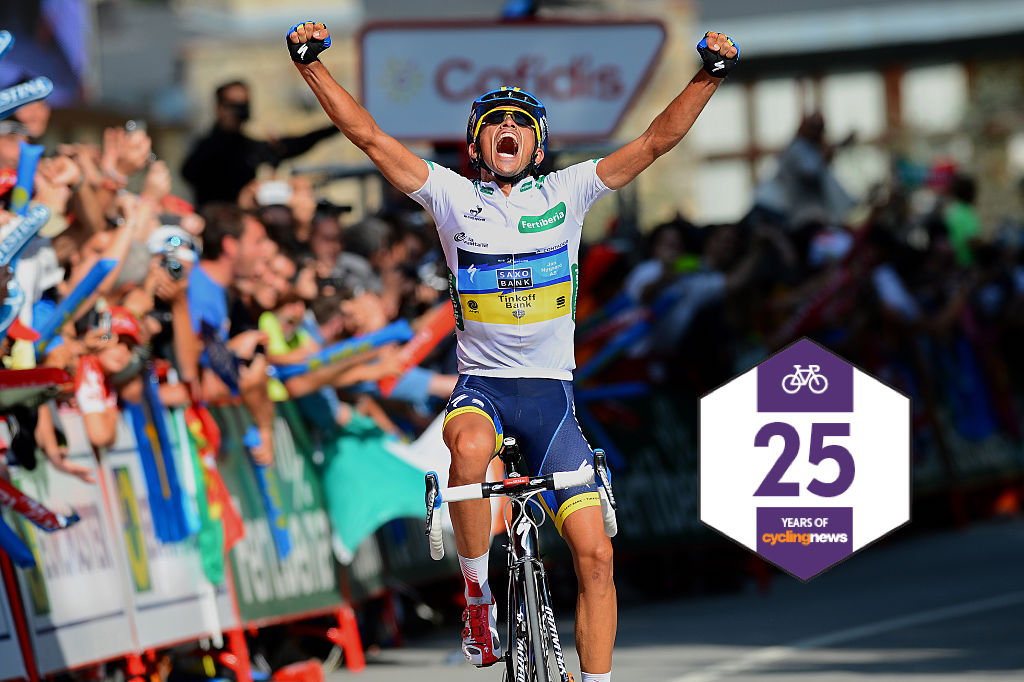
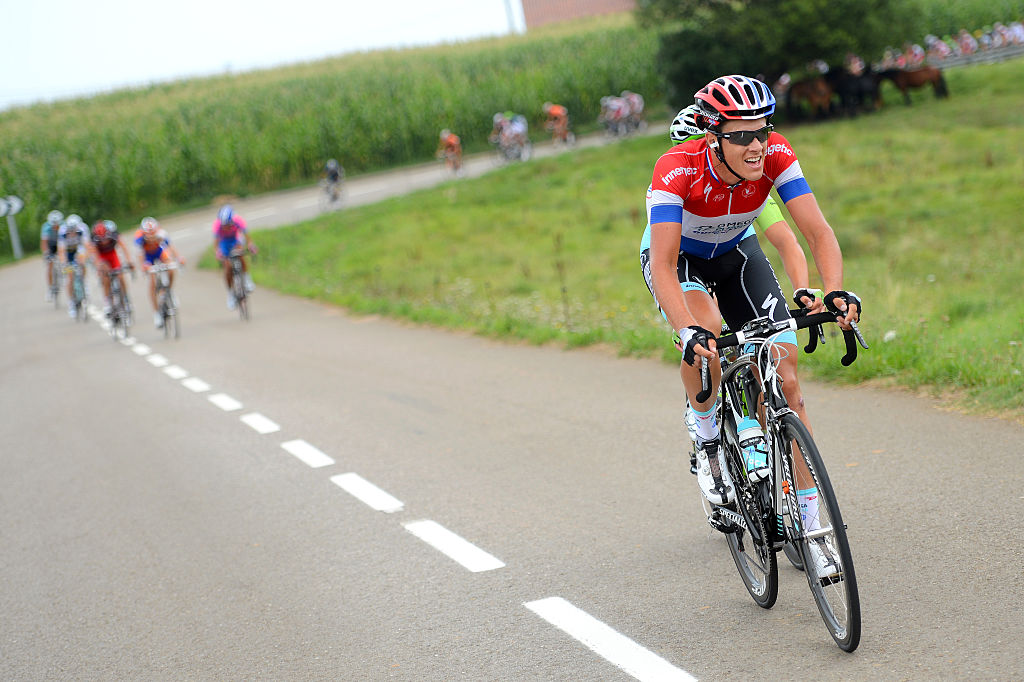
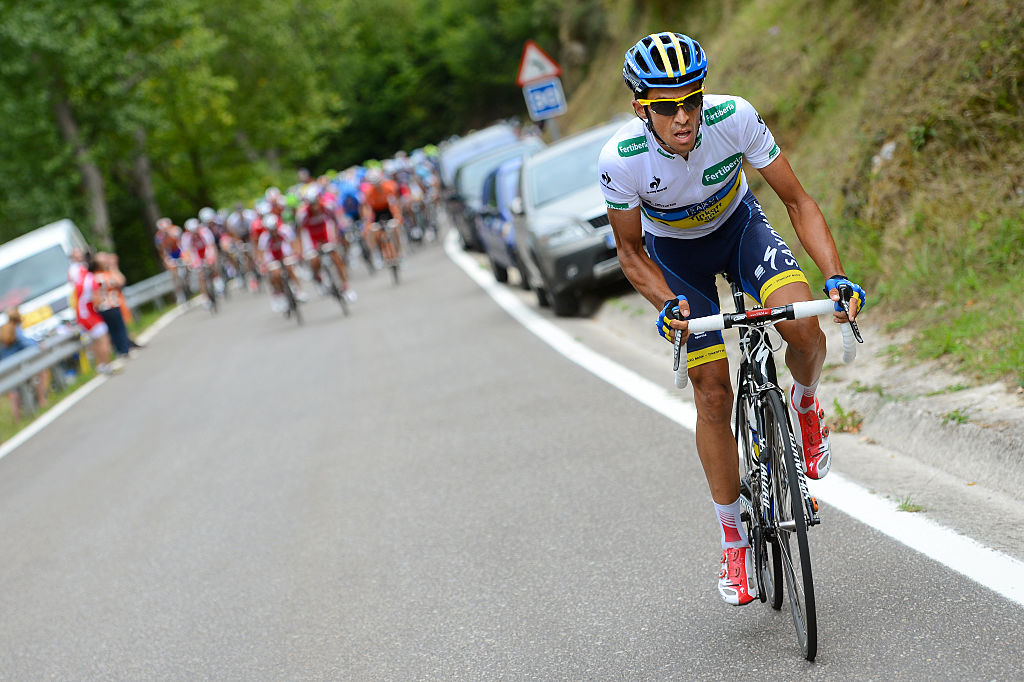
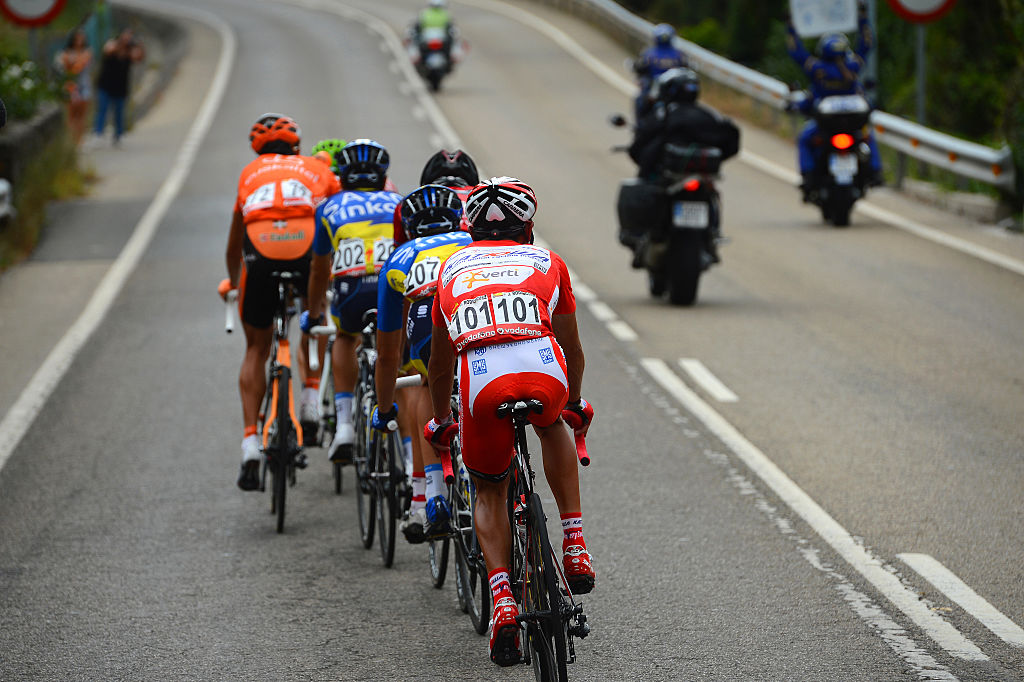
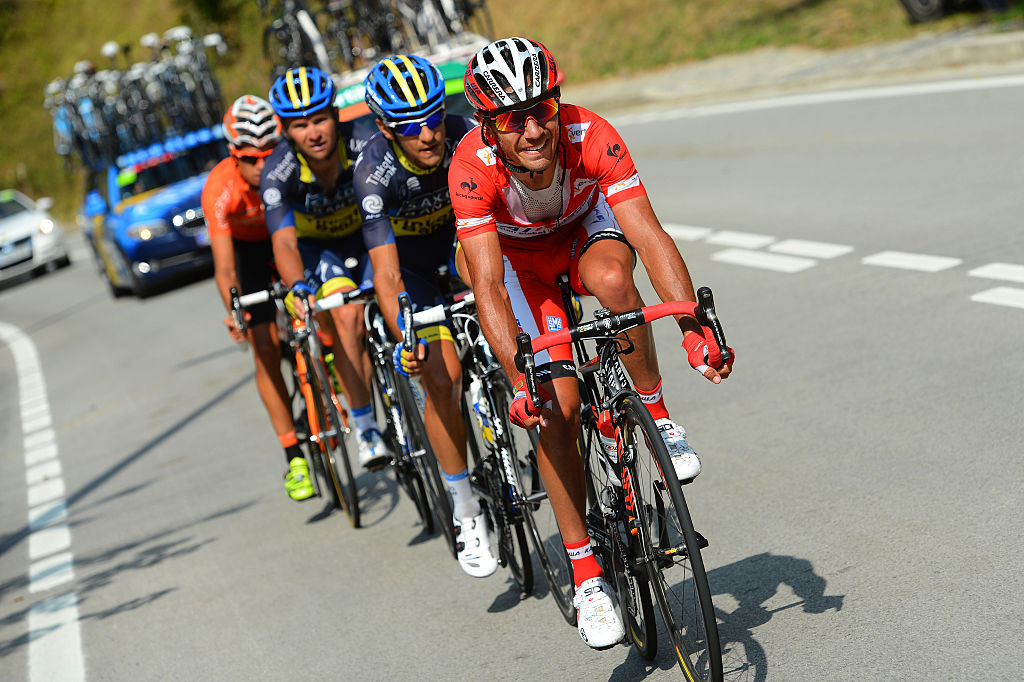
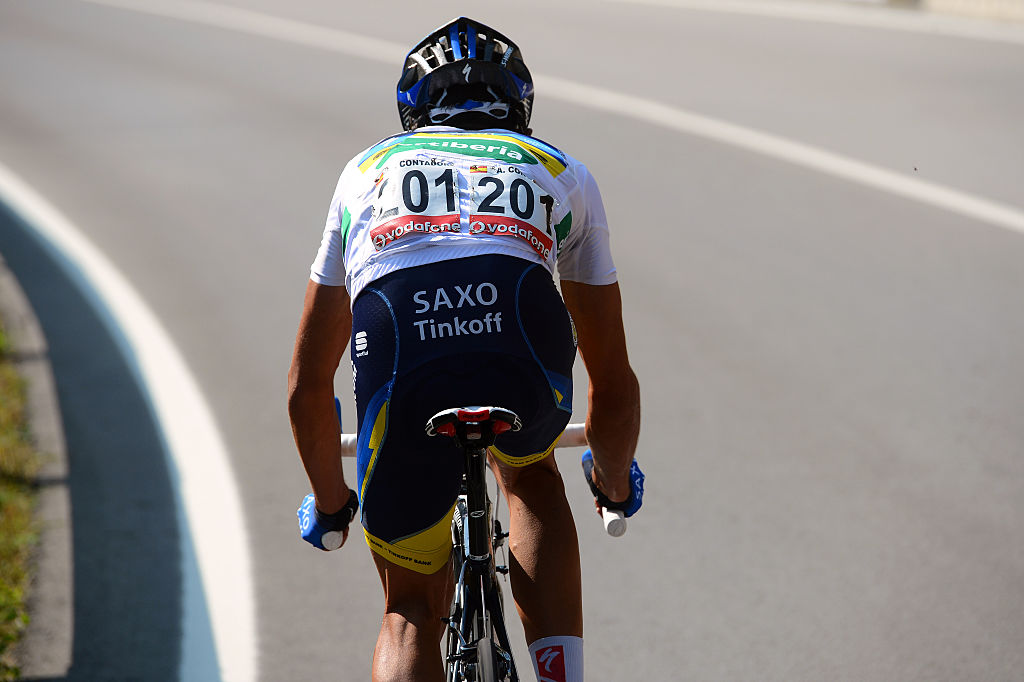
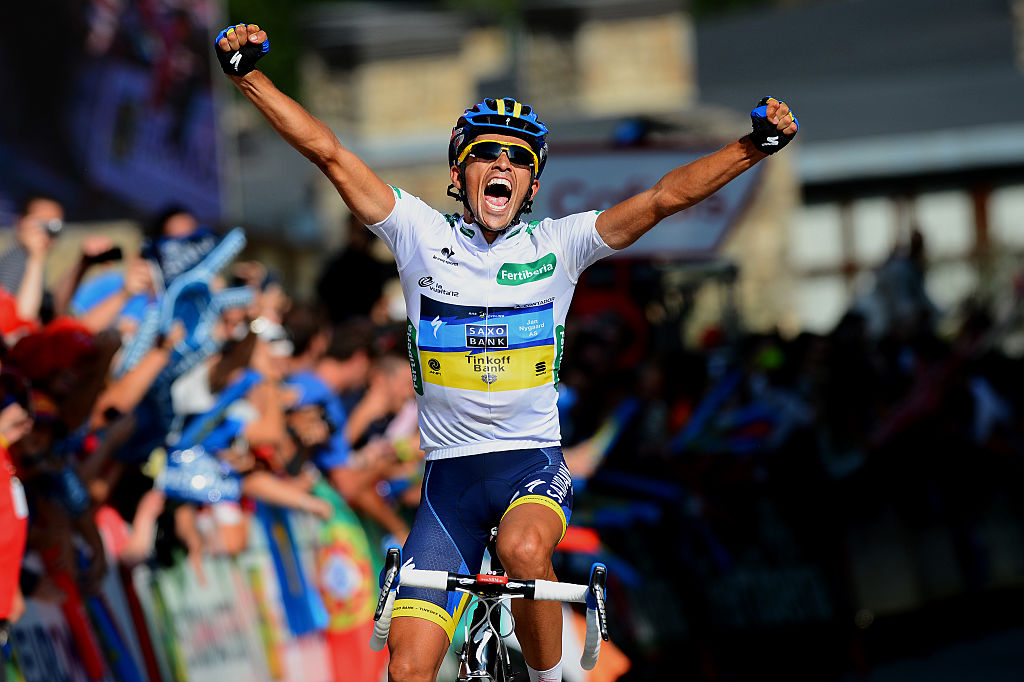
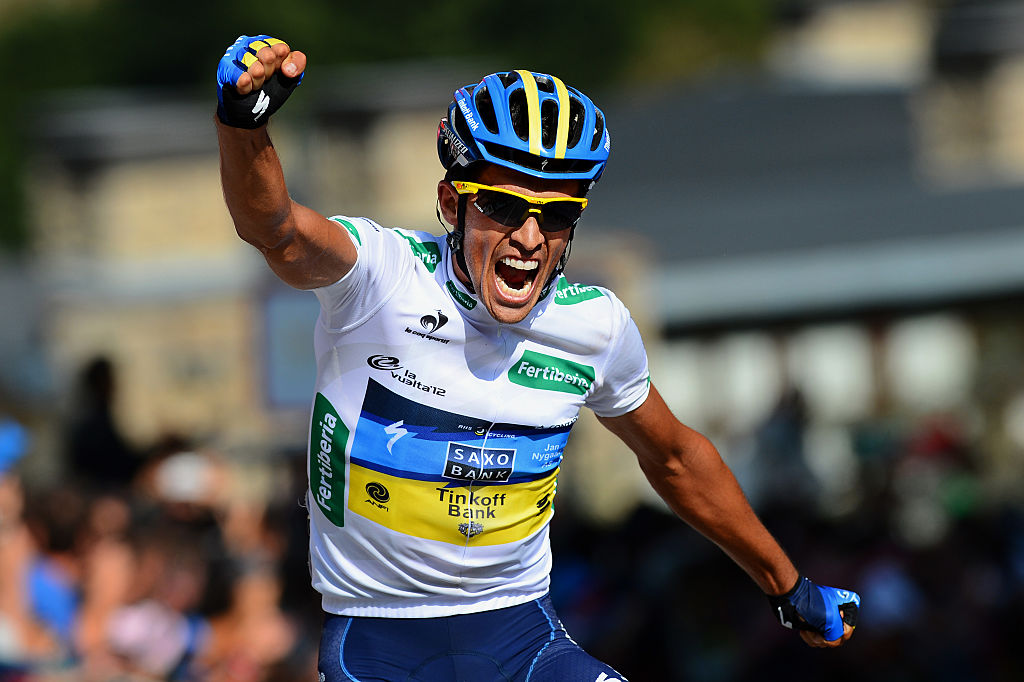
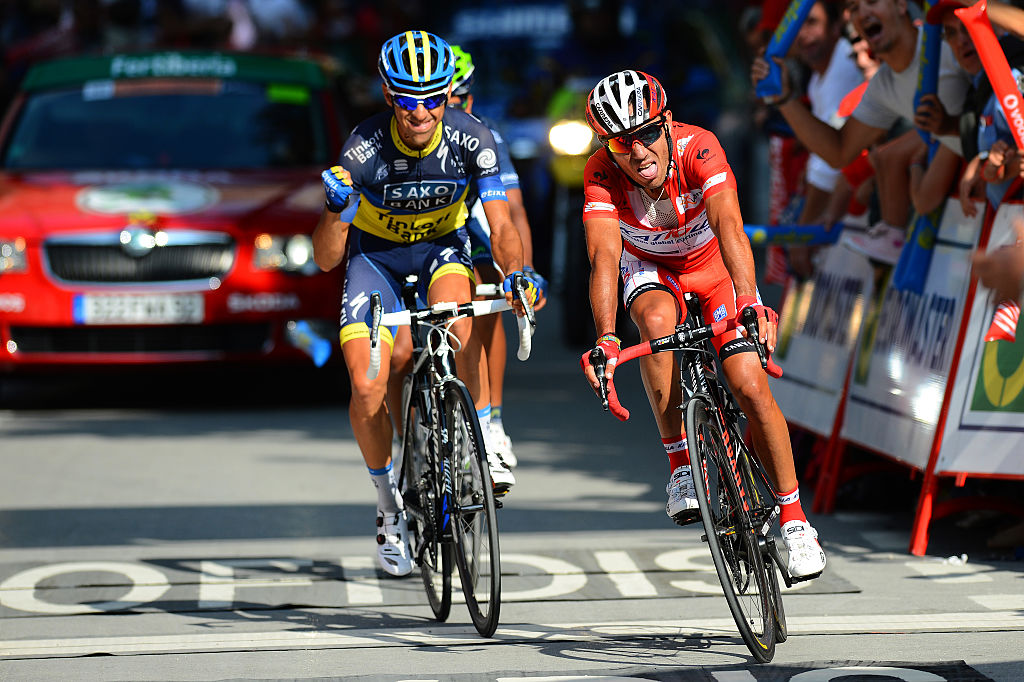
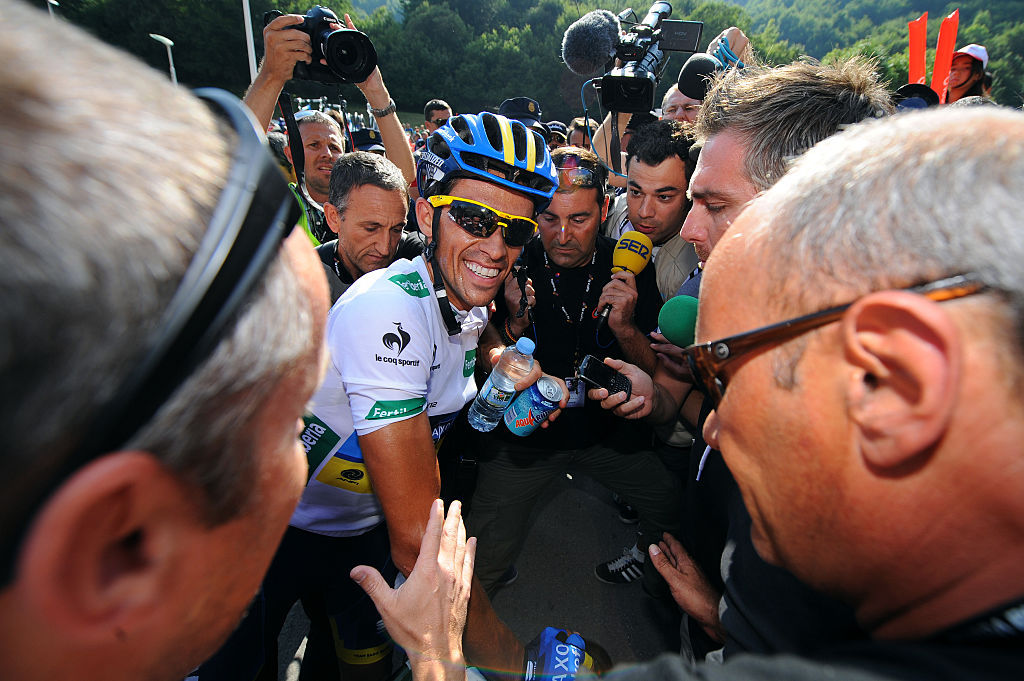
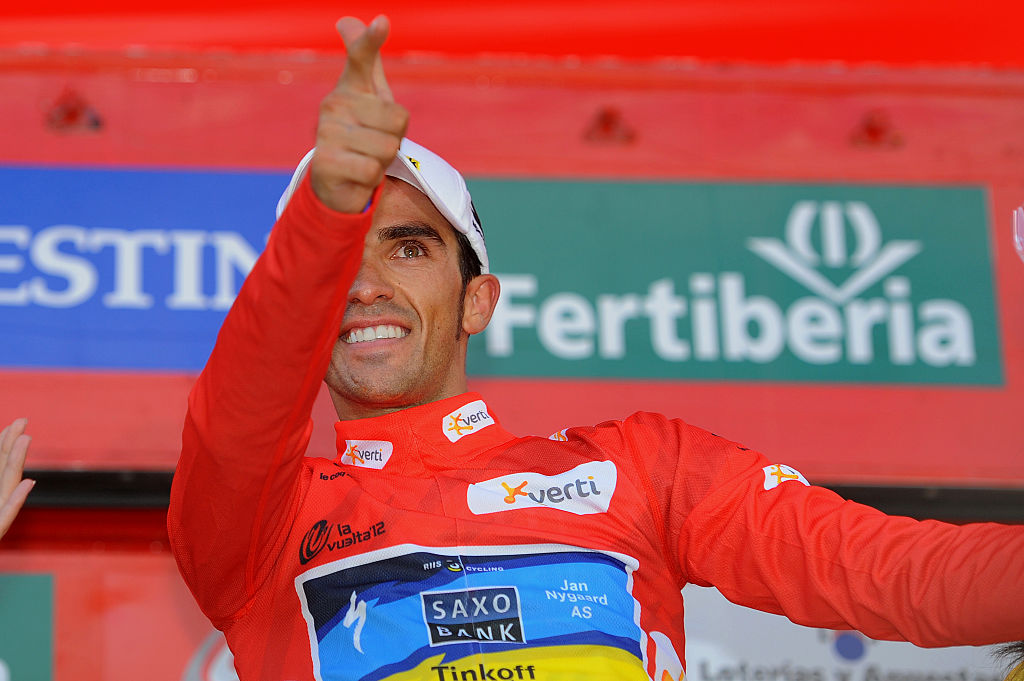
This year, Cyclingnews celebrates its 25th anniversary, and to mark such an important milestone, the editorial team will be publishing 25 pieces of work that look back at the sport over the last quarter of a century.
Sitting in his press conference on the second rest day of the 2012 Vuelta a España, in a sunny hotel conference room overlooking the Bay of Biscay, Alberto Contador (Saxo Bank-Tinkoff Bank) was given the bleak truth with both barrels: he couldn’t win this race.
Or so we all thought.
Immediately prior to the press conference starting, a journalist from a Spanish newspaper had carried out a straw poll among reporters present to find out how many of them considered race leader Joaquim Rodríguez’s (Katusha) advantage of 28 seconds on Contador, lying second overall, sufficient for Purito to win la Vuelta.
All bar two of the dozen or so plumped for Rodríguez to win in Madrid, and from a logical point of view, you could see why. There was no time trial in the final week for Contador, normally much better against the clock than Rodríguez, to turn the tables. At Arrate, Ezcaray, Jaca, Collado De Gallina, Ezaro, Ancares, Lagos De Covadonga and Cuitu Neru - on every previous summit finish of the Vuelta, in fact (and that year the total reached a historic maximum of 10 out of 21 stages) - Purito had either gained time on Contador or been his equal.
He’d even ambushed Contador at Barcelona when he charged away late over an unclassified climb in Montjuic Park with Philippe Gilbert. As the media saw it, Contador neither had options in terms of available terrain, nor his own strength in a mano a mano with Rodriguez. It was game over. (Full confession: I was one of the two who voted for Contador to win the Vuelta, but purely because I had asked the reporter how the survey was going beforehand and felt sorry for the underdog. I didn’t think he could do it, either.)
Bill's excellent adventure
Mark Cavendish: From fat banker to sprinting GOAT
Feed the beast: Covering Lance Armstrong for Cyclingnews
'No further information available': ONCE, McEwen and the 1995 Mount Buller Cup
Behind the scenes: How Cyclingnews reported on the Genevieve Jeanson story
The 25 most memorable races of the last 25 years
But if Contador put on a face like the proverbial cat faced with a bowl of curdled milk when he was given the results of the survey and was asked how he felt about it, he actually smiled a little later when asked who he would bet on to win the overall in Madrid.
Get The Leadout Newsletter
The latest race content, interviews, features, reviews and expert buying guides, direct to your inbox!
"Myself. If I didn’t believe in my own possibilities, then I would be deceiving myself," he answered.
Rather than self-deception, at that point in the game his comment felt more than a little self-delusional. But a little over 24 hours later, at Fuente Dé, as Contador blasted across the line with an enormous shout of triumph and a second Vuelta a España overall victory all but in the bag, suddenly it was embarrassingly clear that we, the so-called experts, had radically underestimated Contador’s revolutionary ability to pull off the most unexpected reversals of fortune, even when all the odds were stacked against him. Or to put it simply, that when he said he thought he could win the 2012 Vuelta, he hadn’t been kidding himself at all.
The morning after Fuente Dé had turned the entire Vuelta upside down, I spent the entire stage start in the town of Aguilar de Campoo talking to riders and team directeurs about what had actually happened. But this wasn’t just collecting raw materials to meld into the typical follow-up article that often appears after an epic stage.
The peloton’s ride to Fuente Dé had been so fast that, on the TV screens at the finish, we had seen relatively little of the live action. Starting in the coastal city of Santander, the stage had essentially consisted of 120 kilometres of rolling terrain along the coast and then 70 hillier ones heading inland, starting with a third-cat climb, then the second-cat Collado De la Hoz, and culminating with the long, very steady, rather dull, 16-kilometre ascent to Fuente Dé. But maddeningly, only the last 28 kilometres were broadcast live.
One thing was clear, from everybody to whom I talked. There had been attacks - non-stop and from the gun. Riders had been getting dropped, all the time, some then re-connecting, some throwing in the towel, only for another attack to go. And another.

“There were bodies everywhere. It was like somebody had stuck their hand in a beehive,” was how Garmin-Sharp Director Johnny Weltz graphically described the scene in the first couple of hours. Even Contador and Alejandro Valverde (Movistar), third overall, had got in one break at one point, ahead of Rodríguez. According to state broadcaster RTVE, it took 80 kilometres for an 11-rider break to form, only for Garmin-Sharp, working for Andrew Talansky, to pull it back.
"It was hard from the start - left, right, up, down, all along the coast," Steve Cummings, then with BMC and a stage winner earlier in the Vuelta, told Cyclingnews that morning. "Big groups were going, splitting and splitting, 40 or 50 guys getting away.
”We did this climb full gas and then I looked round and Alberto and Valverde were there! You knew it was really hard because the GC guys were up there right from the start.
"Then when the [11-rider break] went in the bunch we all thought ‘OK, that's it, now we’ve just got a nice ride to the finish.' And the next thing is that Garmin started riding and then it was just... terrible. Really hard, especially after the rest day," continued Cummings.
"There was a really tough little climb, then that technical descent, little roads - it was terrible, full-on all day. [I remember] the guys' faces in the peloton: I don't want to name names but one guy was almost crying.”
The decisive move, though, where the thread finally broke, was on the Collado De la Hoz.
“Alberto had attacked 27,000 times on that stage and we’d brought him back each time, on the 27,001st time we said, ‘sod it, let’s let him have a bit of time’,” Rodríguez told me a few years ago. But his fatal error, he added, was over-thinking how to respond to that attack.
“I’d worked it out - there were three Movistars ahead with Contador, Alejandro [Valverde] with me, I had two teammates and against all those riders, Alberto had one guy working for him in the break. So that made it seven of us to two of them. We could easily afford to let him go and then bring him back.
“But then the three Movistars ahead didn’t drop back, because of team orders, then Contador managed to get another rider to work for him, and Alejandro didn’t work with me. As a result, that made it three against three.”

At the summit the Contador group of roughly 15 riders, hammering away furiously, had barely a dozen seconds on Rodríguez, in turn isolated in a small group of around a dozen ahead of the Sky-led peloton. But the key thing was, as Rodríguez says, who was in each group.
In fact, Contador’s group had not one but two Saxo Bank teammates - Jesús Hernández and Sergio Paulinho - along with an Astana rider - Italian veteran Paolo Tiralongo - who effectively became a third teammate for the day, to the point where late in the stage you can see he even has a couple of Saxo Bank bidons, handed over from Contador's team car, in his bottle cage. Rodríguez initially had two teammates, as he said, but only one - Katusha’s Alberto Losada - had the strength to do anything effective. Then there was Valverde trailing in Rodríguez’s wake as well, rather than providing some hoped-for support. So rather than three against three, as Rodríguez had re-calculated, it was four against two.
“We heard on the radio, ’20 seconds when they came off the [Collado] climb’,” Saxo Bank Sports Director Bradley McGee told me at the start of stage 18. “We all knew everything was depending on this next time split, ‘cos we would know if Rodríguez had been able to pull it back. And it went up to 25 seconds and we all went ‘ooh!’.
“Once we hit the valley floor, it was man against man, Paulinho and Contador versus Losada and Rodríguez. And it went out a bit more, bit more and then it just exploded.”
A Purito-Pistolero duel
Often regarded as a breakthrough moment in Contador’s career and the start of a new, rollercoaster, post-ban chapter, Fuente Dé was also the culmination of the 2012 Vuelta. It’s worth a quick look back at how the race could be settled so decisively on the second half of a single ‘transition' stage. Because, as Rodríguez and Contador revealed in a lengthy Instagram live chat that went online this spring, there were plenty of other factors beyond Fuente Dé that had led to the Vuelta, by that point, boiling down to a Purito-Pistolero duel.
To sum up very roughly, on GC four riders had come to the fore in the Vuelta’s first week: Contador, Rodríguez, Chris Froome (fresh off a second place in the Tour) and Valverde. But oddly, even if Rodríguez was slowly inching ahead on GC, deep into the second week, Contador was, as he said, “more worried about Froome." And this was despite both the Briton, exhausted after his second place behind Bradley Wiggins in the Tour, and Valverde slowly fading out of the picture from the end of the first week onwards.
But Contador didn’t seem to care. He was fixated on Froome, to the point where he even collaborated with Rodríguez on the stage 12 Ezaro summit finish, just to be sure the Briton was dropped.
“You attacked on Ezaro, and I went with you, then I looked back, saw a Sky rider, realised it was [Rigoberto] Urán, not Froome, and thought, ‘right, let’s go for it’,” Contador told Rodríguez. “I’d watched Froome in previous Grand Tours and I’d seen how Chris always got stronger in the third week, and I was determined he wouldn’t get back in the action late on.”
But the end result was that, while Froome got pushed further and further out of the picture, in the process Contador let a Purito-shaped genie out of the GC bottle, as at Ezaro and on stage after stage finish, Rodríguez was able to shoot ahead of Contador and pick off seconds, time and again.

On Cuitu Nero, the ultra-steep final ascent of the second week, we had reached a familiar pattern: Rodríguez let Contador set things up with his Saxo team on the front all the way up the preceding Pajares ascent, then watched and waited as Contador launched multiple attacks - Cyclingnews later estimated them to be roughly a dozen - each starting with a blazing acceleration that all but created a spark-trail under his wheels, and then equally as quick, thanks to his inability to sustain that initial move, crumpling into thin air. Then after reeling Contador in, time after time, within sight of the finish, Rodríguez darted ahead, yet again to snatch a couple of seconds. “It kept on happening one day after another, I was getting so fed up, desperate,” Contador reflected this spring.
As a result of Rodríguez’s strength and Contador’s miscalculations, come the second rest day, the Vuelta tide looked to be set solidly in Rodríguez's favour for him finally to win a Grand Tour.
But there were undercurrents. Some were as innocent-looking as McGee having gone out earlier in the year to northern Spain to recon a number of climbs, among them the Collado De la Hoz and - critically - the twisting, narrow valley road that followed where Rodríguez struggled to organise a chase group. Having that data ready and to hand in the team car when Contador attacked was to prove invaluable.
Another undercurrent was that Saxo Bank had “got wind that Katusha hadn’t bothered to go training on the rest day, they were too busy celebrating Rodríguez’s win a week in advance,” as Contador’s former press officer, Jacinto Vidarte, told Cyclingnews. “So we were ready to go for it.”
Yet another was Contador’s own determination to beat Rodríguez, set to a maximum after a week where Rodriguez had been racking up the seconds by surfing off Saxo’s efforts to drop him.
“I think it was on Cuitu Neru that I lost the Vuelta,” Rodríguez recounted. “Beating you there pissed you off so much, I think you decided there and then you would attack me all the time even if I was in the middle of taking a shower.”
You can't give Contador even 10 metres - 'he’ll take everything'
By the time RTVE’s live broadcast began on the Fuente Dè stage, much of the high drama had already happened, but it was still electrifying to watch. Contador, supported by Paulinho (Hernández had fallen behind by this point), was steadily forging open a gap in the front group. By 23 kilometres to go, the gap had risen to 90 seconds, and it was clear Contador, assuming he did not suddenly crack, would take the lead. The only question was by how much.
Things turned even worse for Rodríguez when Paulinho wheeled across and Contador went clear with Tiralongo, with 22 kilometres to go, and the two worked brilliantly together. “That [collaboration] was his thanks for the stage I had gifted him in the Giro the year before,” Contador stated in his Instagram interview, while behind Rodríguez, flailing wearily at the front of the group, had no such favours he could call in, with only Alessandro Ballan offering the occasional turn alongside a rapidly fading Losada.
“Valverde was in the group, sitting behind, and then he attacked me,” Rodríguez said afterwards. “He was nice enough to come up and warn me and even apologize for it first, though. But then he was off the front and away.”
By this point, Tiralongo had done pulling and Contador, alone now, was nearly home and dry, with his lead up to well over two minutes as he hauled into the final kilometre, plus a time bonus he had taken at the foot of the climb. Interestingly, in the final chunk of the stage, when Contador was alone and Rodríguez chasing behind, rather than the gap yawning open even further, it didn’t rise more than another 30 seconds. The real damage, time-wise, was done when Contador had the backing of his teammates and Tiralongo on a smooth, gentle ascent like Fuente Dé, where there was no risk of the collaboration buckling under steeper, more irregular slopes.
However, it was Contador who had laid down the dynamite in the first place and lit the fuse with his attacks, and not even his teammates knew it was going to happen.
“On the bus, the plan was we were going to attack three kilometres from the top,” Paulinho told me afterwards. “It was a climb where nothing was meant to happen.” Instead, somebody tore up the script, big time.

What could we make of a game-changer as devastating as Fuente Dé? “Contador had decided It was time to push back cycling to its rudimentary nature of half a century ago,” Eduardo Rodríguez Alvarez wrote in the following day’s edition of Spain’s best-selling daily, El País. “To become the Cannibal, or Tarangu [legendary Spanish firebrand José Manuel Fuente], or whoever it called for him to be. To fire that last bullet.”
“A revolutionary, a non-conformist who never gives up,” was how double Vuelta winner Pedro Delgado, RTVE’s co-commentator, described him. “It just goes to show, you can never risk giving Contador any kind of advantage. Not even 10 metres. Because he’ll take everything.”
And as he closed on the line, having taken far more time than anyone could have calculated, Contador’s only practical concern was probably Valverde, fast closing the gap behind and closing in on second place ahead of Rodríguez as he did so.
But Valverde failed to reach him, and when Contador blazed across the line, shouting at the top of his voice - “so loud it must have woken up the bears in the [nearby] Picos De Europa [mountain range]”, wrote Rodríguez Alvarez - there were still six seconds in Contador’s favour. Rodríguez was 2:38 down, and Contador’s old bugbear Froome at nearly five minutes. The Vuelta was all over bar the shouting.

“I didn’t want the stage win that day as much as I wanted time on the overall,” Contador said recently. But it was the sight of Contador powering across the line with his mouth wide open that made the front pages of every newspaper the next morning. “He looked like a lizard but in fact he was a viper,” wrote Rodríguez Alvarez, “and he ate the entire Vuelta.”
Contador’s victory that day didn’t just project him towards the future, it was also a kind of release or sporting redemption. Fuente Dé was Contador’s first win since coming back from his doping ban that had left him out for the count for most of 2012, and with his 2011 and 2010 results, including Giro and Tour wins, scratched from the record books. As such, it constituted not only a rise from the ashes of defeat after defeat by Rodríguez on the Vuelta’s climbs but also this was a bounce-back in grand style right up into the highest echelons of Grand Tour contention.
And if Contador’s victory was such that it has come to sum up his career, do spare a thought for Rodríguez, the rider condemned to be forever reminded about losing at Fuente Dé. Not only was he pushed down from second to third overall thanks to Valverde’s late attack, that summer he had already been chewing over the dregs of another bitter defeat: losing the Giro d’Italia earlier in the year by the bare minimum to the unheralded, if well-deserved, Ryder Hesjedal (Garmin-Barracuda).
But Milan didn’t matter to the fans. As Rodríguez put it in the Instagram interview, “even now, if I come across another rider while I’m training, all they ever do is say ‘eh, so what happened in Fuente Dé, eh?’”
But he also reflected that while the defeat will always be with him, “How could I be angry about what happened? Somebody who was braver than me beat me.”

El espectáculo
For a hefty chunk of the Spanish media, Fuente Dé and what effectively became a victory procession on the four stages left before Madrid was a dream ending. Here was their local hero, the greatest Spanish racer since Miguel Indurain, back from a ‘sanction’ - as most persisted in calling Contador’s doping ban - and sporting exile to triumph on home soil.
After quiet sniping about how the Vuelta’s 10 summit finishes had been failing to produce anything but deadlock, suddenly, they repeatedly wrote, thanks to a transition stage - race organisers take note - 2012 was ‘the best Vuelta in history’.
Even now, Fuente Dé remains a favourite feel-good movie for Spanish sports fans, with the stage most recently rolled out by RTVE this spring on television again, during the country’s grim pandemic lockdown. Regrettably, we still only got to see the last 28 kilometres.
But for Contador, the impact of Fuente Dé went a long, long way beyond that particular Grand Tour win, his fifth - or seventh, as he would see it - in his career. It came to sum up the Contador attitude towards racing, of valuing el espectáculo, as it’s called in Spanish, which translates rather badly as sporting entertainment, but at heart, a philosophy of attacking without overly thinking or calculating what the outcome would be. Throwing the dice and hoping, basically. Or, like his oft-quoted personal motto put it, querer es poder: where there’s a will, there’s a way. You just have to find it.
That particular duality of "heart against head" is almost as old as bike racing itself. To name but a few previous occasions when it has dominated the men’s road racing narrative, you can see elements of that conflict in the Luis Ocaña versus Eddy Merckx battles, or Marco Pantani (Contador’s childhood hero, as it happens) versus Jan Ullrich, or Claudio Chiappucci versus Miguel Indurain.
But at a time when Team Sky had just dominated the 2012 Tour de France with a strategy of clamping down on their rivals in the mountains then destroying them in the time trials, which was as effective as it was dull, not to mention their showing every intention of repeating the same monotonous show each time July swung round with the so-called Skybots, Contador’s non-conformism felt like a hugely necessary blast of fresh air.

Fuente Dé provided the perfect justification for that romantic strategy of the eternal outsider - because it had worked once, in such a massively public way, there was always the possibility that it might again. In a sense, Contador’s 2014 victory against Froome in the Vuelta was another variation on the same theme, given El Pistolero was injured just when he was going to win the Tour, but then, even racing with a recently broken shinbone, he still managed to pull off 'Mission Impossible' and beat Team Sky.
And so the espectáculo Contador myth-making rolled on, even sometimes getting as predictable, its detractors might say, as the overly repeated, inaccurate, simplification of his arch-rivals, Sky and their Skybot riders as a ‘machine’. In 2015, having won the Vuelta in 2014, taking just the Giro or the Tour was not enough. Rather, Contador opted to up the stakes and go for the double because, well, querer es poder.
In 2017, when the Vuelta went over the Collado de la Hoz en route to Froome’s second win, half the newspapers and websites in Spain were asking ‘would Contador try it again?’ (The answer was ‘yes’ with a mere seven attacks, but none of them worked out.) Then of course, there was his last, dramatic throw of the dice on the Angliru in the 2017 Vuelta. And we all know how that ended.
But in the public’s imagination, it all stemmed back to Fuente Dé and the moment we were plunged, willy-nilly, into the middle of his personal revolution. Intentionally or not, Contador himself helped consolidate the stage’s legendary status. In his own personal bike museum at his home in Pinto, as Cyclingnews saw a few years ago, the huge picture that serves as the backdrop behind all his bikes isn’t Contador winning the Tour de France in 2009 or the Giro d’Italia in 2015, it’s him crossing the line at Fuente Dé.
However, like any myth, the truth is not so simple, and in fact, as Vidarte told Cyclingnews, the 2012 Vuelta was not, by a long shot, the first time Contador had ripped up the script in such dramatic style in a race.
“It was one of his trademark moves, even when he was an amateur,” said Vidarte. (It even turns out that back when he was a junior he had tried a similar long-distance move on the same climb, Collado de la Hoz, in one of Spain’s now-defunct, top amateur races, the Circuito Montanés. And lost.) "When I was with him as his press officer, I'd lose track of the times he just ignored team orders and did whatever he wanted to or what his race instinct told him to do.”
Citing the most famous occasions, Vidarte recollected, “a Paris-Nice [in 2007] where he had lost some time the stage before the Col d’Eze and it looked as if he was going to lose the race overall, but then he turned things around with one of these all-out, uncalculating, attacks. Then there was the 2009 Tour, where he went up the road despite [Johan] Bruyneel telling him to do the opposite. Or the 2008 Giro, when Bruyneel rang him up to tell him to abandon so he could go to the Dauphiné and he just ignored the call. And then of course there’s Contador’s long-range attack en route to Alpe d’Huez in the 2011 Tour. Or in Paris-Nice a couple of years before he retired.
“The Tour is obviously a bigger prize than the Vuelta. But we didn’t really know about Bruyneel’s phone calls or team orders until later. So even if he’d done an attack like Fuente Dé before in much bigger sporting arenas, Fuente Dé is the most striking of them all. And maybe that’s why it’s the one that’s endured.”

Alasdair Fotheringham has been reporting on cycling since 1991. He has covered every Tour de France since 1992 bar one, as well as numerous other bike races of all shapes and sizes, ranging from the Olympic Games in 2008 to the now sadly defunct Subida a Urkiola hill climb in Spain. As well as working for Cyclingnews, he has also written for The Independent, The Guardian, ProCycling, The Express and Reuters.
